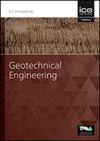The numerical investigation of the main factors influencing rocking responses of shallow foundations
IF 1.7
4区 工程技术
Q3 ENGINEERING, GEOLOGICAL
Proceedings of the Institution of Civil Engineers-Geotechnical Engineering
Pub Date : 2023-06-19
DOI:10.1680/jgeen.22.00175
引用次数: 0
Abstract
Several investigations show that structures with rocking foundations bring more stability and fewer post-earthquake damages to superstructures by dissipating seismic energy within the underlying soils. Nevertheless, there are still obstacles to making this design philosophy a practical solution, including concerns about the residual settlements and rotations. In order to provide a better insight into the problem, the present paper investigates the performance of a simple structure with a rocking foundation, taking advantage of pushover and time history analyses. The finite element method is applied for the study, and the numerical model has been validated using results from recent experimental research. Accordingly, the effect of a number of influential parameters involving the properties of soil, structure, and ground motions is evaluated. Current research considers different static safety factors against soil shear strength failure, structure slenderness ratios, earthquake records, and foundation embedment depths, and the response of the systems with rocking foundations has been elaborated using the obtained results. The contribution of the investigated parameters is pronounced in the main features of the rocking foundation performance, such as the system moment capacity and foundation deformations (settlement and rotation).影响浅基础摇摆响应主要因素的数值研究
一些研究表明,具有摇摆基础的结构通过耗散下伏土体中的地震能量,使上部结构具有更高的稳定性和更小的震后破坏。然而,使这种设计理念成为一个实用的解决方案仍然存在障碍,包括对残余沉降和旋转的关注。为了更好地理解这一问题,本文利用推覆分析和时程分析对一个简单结构在摇摆基础下的性能进行了研究。采用有限元方法进行了研究,并利用近年来的实验结果对数值模型进行了验证。因此,一些有影响的参数,包括土壤,结构和地面运动的性质的影响进行了评估。目前的研究考虑了不同的静力安全系数对土体抗剪强度破坏、结构长细比、地震记录和基础埋深的影响,并利用所得结果阐述了摇晃基础下体系的响应。所研究的参数对摇摆基础性能的主要特征,如系统弯矩承载力和基础变形(沉降和旋转)的贡献是明显的。
本文章由计算机程序翻译,如有差异,请以英文原文为准。
求助全文
约1分钟内获得全文
求助全文
来源期刊
CiteScore
4.40
自引率
4.50%
发文量
68
审稿时长
3 months
期刊介绍:
Geotechnical Engineering provides a forum for the publication of high quality, topical and relevant technical papers covering all aspects of geotechnical research, design, construction and performance. The journal aims to be of interest to those civil, structural or geotechnical engineering practitioners wishing to develop a greater understanding of the influence of geotechnics on the built environment.

 求助内容:
求助内容: 应助结果提醒方式:
应助结果提醒方式:


